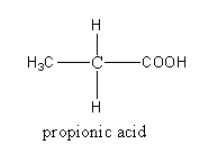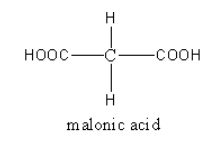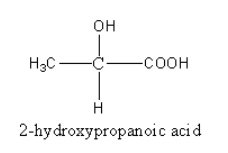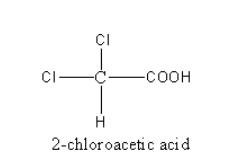Answer
405.3k+ views
Hint: For a compound to be optically active, the presence of a chiral centre is necessary. A carbon whose all valancy are satisfied by different substituents is known as a chiral centre. The compound having no chiral centre is known as optical inactive.
Complete Step by step answer:A compound having a chiral centre will be optically active. A carbon centre having four different substituents is known as a chiral centre.
The chiral molecule rotates the light in a clockwise direction are known as dextrorotatory and represented by \[\left( + \right)\] sign and the chiral molecule rotate the light in an anticlockwise direction are known as laevorotatory and represented by \[\left( - \right)\] sign.
Write the structure of all the compound to determine the chiral centre as follows:

The propionic acid has two hydrogens, one methyl and one carboxylic group. So, propionic acid has only three types of substituents. So, propionic acid is not optically active.

The malonic acid has two carboxylic, and two hydrogen groups. So, malonic acid has two types of substituents. So, malonic acid is not optically active.

The $2 - $hydroxypropanoic acid has one hydrogen, one methyl, one hydroxy and one carboxylic group. So, $2 - $hydroxypropanoic acid has four different substituents. So, $2 - $hydroxypropanoic acid is optically active.

The $2 - $chloroacetic acid has one hydrogen, two chlorine, and one carboxylic group. So, $2 - $ chloroacetic acid has three types of substituents. So, $2 - $chloroacetic acid is not optically active.
So, only $2 - $hydroxypropanoic acid is optically active.
Therefore, option (C) \[{\text{C}}{{\text{H}}_{\text{3}}}{\text{CH(OH)COOH}}\] is correct.
Note: A chiral molecule can be optical inactive in two conditions: first, if the molecule has symmetry such as tartaric acid having a plane of symmetry. Second, if the molecule exists in two enantiomers and both are present in equal amounts and both rotate the light in opposite directions. This type of mixture when two enantiomers of a chiral molecule present in the same amount and both rotate the light in opposite directions is known as a racemic mixture.
Complete Step by step answer:A compound having a chiral centre will be optically active. A carbon centre having four different substituents is known as a chiral centre.
The chiral molecule rotates the light in a clockwise direction are known as dextrorotatory and represented by \[\left( + \right)\] sign and the chiral molecule rotate the light in an anticlockwise direction are known as laevorotatory and represented by \[\left( - \right)\] sign.
Write the structure of all the compound to determine the chiral centre as follows:

The propionic acid has two hydrogens, one methyl and one carboxylic group. So, propionic acid has only three types of substituents. So, propionic acid is not optically active.

The malonic acid has two carboxylic, and two hydrogen groups. So, malonic acid has two types of substituents. So, malonic acid is not optically active.

The $2 - $hydroxypropanoic acid has one hydrogen, one methyl, one hydroxy and one carboxylic group. So, $2 - $hydroxypropanoic acid has four different substituents. So, $2 - $hydroxypropanoic acid is optically active.

The $2 - $chloroacetic acid has one hydrogen, two chlorine, and one carboxylic group. So, $2 - $ chloroacetic acid has three types of substituents. So, $2 - $chloroacetic acid is not optically active.
So, only $2 - $hydroxypropanoic acid is optically active.
Therefore, option (C) \[{\text{C}}{{\text{H}}_{\text{3}}}{\text{CH(OH)COOH}}\] is correct.
Note: A chiral molecule can be optical inactive in two conditions: first, if the molecule has symmetry such as tartaric acid having a plane of symmetry. Second, if the molecule exists in two enantiomers and both are present in equal amounts and both rotate the light in opposite directions. This type of mixture when two enantiomers of a chiral molecule present in the same amount and both rotate the light in opposite directions is known as a racemic mixture.
Recently Updated Pages
How many sigma and pi bonds are present in HCequiv class 11 chemistry CBSE

Why Are Noble Gases NonReactive class 11 chemistry CBSE

Let X and Y be the sets of all positive divisors of class 11 maths CBSE

Let x and y be 2 real numbers which satisfy the equations class 11 maths CBSE

Let x 4log 2sqrt 9k 1 + 7 and y dfrac132log 2sqrt5 class 11 maths CBSE

Let x22ax+b20 and x22bx+a20 be two equations Then the class 11 maths CBSE

Trending doubts
Fill the blanks with the suitable prepositions 1 The class 9 english CBSE

Which are the Top 10 Largest Countries of the World?

Write a letter to the principal requesting him to grant class 10 english CBSE

Difference between Prokaryotic cell and Eukaryotic class 11 biology CBSE

Give 10 examples for herbs , shrubs , climbers , creepers

Fill in the blanks A 1 lakh ten thousand B 1 million class 9 maths CBSE

Change the following sentences into negative and interrogative class 10 english CBSE

Difference Between Plant Cell and Animal Cell

Differentiate between homogeneous and heterogeneous class 12 chemistry CBSE



